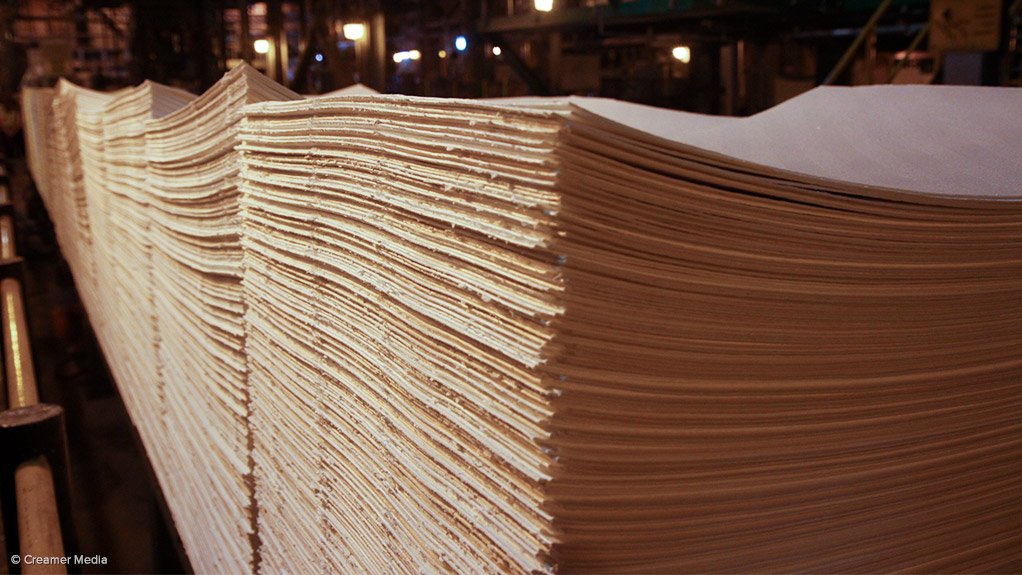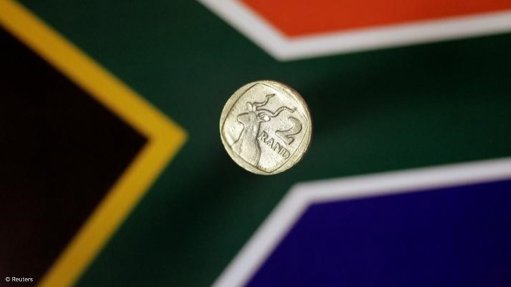Sappi recovers strongly after Covid-19 impact
Pulp and paper producer Sappi has returned to profitability for the financial year ended September 30, turning a loss of $135-million in 2020 into a profit of $13-million for 2021, with earnings before interest, taxes, depreciation, amortisation (Ebitda) having increased by 40% over the prior year.
Speaking to Engineering News on November 11, CEO Steve Binnie said the Covid-19 pandemic “had a dramatic impact on the business and all of its segments”, but a “steady improvement” was seen over the last 12 months, culminating in both a stronger fourth quarter and returning the company to profitability for the full-year period.
He added that, while the Sappi team overcame significant challenges posed by Covid-19, the company was “not fully back to pre-Covid levels” though it continued to move in the right direction as the company now anticipated growth in the first quarter of the 2022 financial year and the year ahead.
Apart from the pandemic, Sappi is also faced with cost inflation linked to the bounce back from Covid-19, adding to which are shipping challenges, more specifically at the Durban port, where the company currently has a 100 000 t backlog of inventory.
Further, highlights for the year include the recovery in the profitability of the dissolving pulp (DP) segment, driven by buoyant demand and significantly better market prices, as well as the North American region delivering its highest financial year Ebitda in over a decade.
Sappi’s strategy of investing in packaging and speciality papers reaped rewards as the segment achieved record profitability and sales volumes increased by 21%, the company said in a separate statement on Thursday.
It added that, throughout this unprecedented time, the health and safety of its employees remained paramount and, as such, a comprehensive Covid-19 action plan enabled Sappi to operate in a safe and uninterrupted manner where demand permitted.
“Working closely with our customers and suppliers, we systematically increased activity and output in response to improved market demand and our support for local communities helped mitigate the impact of the pandemic and the ensuing socioeconomic consequences on them,” the company explained.
As Covid-19 lockdowns eased and economic activity resumed, global trade rebounded much faster than initially anticipated.
However, the requirement for shipping surged, which triggered vessel and container shortages, severe port congestion and significant freight rate increases.
The logistical disruptions described above severely constrained Sappi’s export sales in all regions, and by year-end, this resulted in a backlog of deliveries of 100 000 t of DP.
The impact on earnings from this backlog amounted to about $30-million.
Additionally, high demand for raw materials and commodities, coupled with long lead times and an inability to restock inventories, fuelled worldwide inflationary pressures.
Consequently, escalating delivery and raw material costs, particularly bought pulp, chemicals and energy, negatively impacted margins in all product segments. To mitigate the impact of these rising costs, Sappi implemented a series of price increases in its paper businesses.
While market conditions improved, the focus was maintained on the preservation of liquidity and prudent cash management.
Strategic actions were re-prioritised, while variable and fixed costs continue to be reviewed.
The project to expand the Saiccor Mill capacity was impacted negatively by Covid-19 lockdowns and associated travel restrictions, which delayed the project schedule.
Commissioning of the plant began during the fourth quarter and will be completed in the first quarter of the 2022 financial year.
Turning to the financial results for the fourth quarter, Binnie said Sappi’s ongoing recovery from Covid-19 continued, with high DP prices and an excellent performance by the North American business having more than offset escalating raw material costs and ongoing supply chain challenges, which constrained shipments and negatively impacted on delivery costs.
The South African civil unrest in July, coupled with supply chain challenges, including a cyberattack and equipment failure at the Durban port, along with adverse weather events, had a negative impact on fourth-quarter Ebitda.
Notwithstanding this, group Ebitda increased by 22% to $177-million from the $145-million achieved in the third quarter.
Meanwhile, viscose staple fibre (VSF) prices dropped during the quarter owing to higher inventory levels and a delay in the seasonal upswing in demand ahead of the Chinese national holidays in September.
Despite the lower sales volumes compared with the prior quarter, Ebitda for the segment increased by 38% owing to beneficial pricing which peaked in the third quarter and formed the basis of fourth-quarter contract prices.
Sales volumes in the packaging and speciality papers segment increased by 10% compared with the equivalent quarter in the prior year as the North American business experienced encouraging sales growth and margin improvements across all of the major product categories.
Growth in European packaging and specialities sales volumes was hampered by weaker demand for certain non-essential luxury product categories and prolonged speciality paper qualifications. Containerboard demand in South Africa was robust on the back of strong fruit exports. Ebitda for the segment improved by 21% year-on-year.
Graphic paper demand continued to recover and, combined with industry capacity closures, ensured the market balance in Europe and North America was restored to healthy levels.
However, Sappi bemoaned that profitability in Europe remained a challenge owing to inflationary cost pressures, and that low industry inventory levels and longer delivery lead times linked to the global supply chain challenges provided support for price increases during the quarter.
Earnings a share, excluding special items for the quarter were $0.11, which was a substantial improvement on the $0.05 of the prior quarter and indicative of the recovery in profitability for the group.
Net cash generated for the quarter was $33-million, compared with $88-million in the equivalent quarter last year. The decrease was primarily as a result of increased capital expenditure of $143-million related mainly to the expansion of DP capacity at Saiccor Mill.
OUTLOOK
Overall market conditions for DP continue to be strong. However, Sappi said short-term demand in China was being impacted on by the recent implementation of energy savings regulations which impose curtailments for energy intensive manufacturing operations across the country.
The textile value chain has been negatively impacted, thereby reducing VSF production and DP demand. Consequently, DP market prices dropped to $940/t in October.
However, lower VSF supply and a widening price differential to cotton fuelled a significant rise in VSF pricing, which the company said, “should be positive for DP pricing”. Sappi’s sales volumes are not expected to be impacted by the weaker Chinese DP demand.
The recovery of demand for graphic paper, combined with industry capacity closures, has tightened the market balance. In North America, restrictions on imports owing to global supply chain disruptions have further contributed to a positive environment in this region.
The underlying demand in the packaging and speciality papers segment remains robust in both the North American and South African regions and opportunities for further growth in sales volumes exist in Europe.
The scheduled Somerset Mill yearly maintenance shutdown, which includes a seven-year cold outage, will have an estimated $22-million impact on profitability in the first quarter of the 2022 financial year.
Recent spikes in global energy prices for gas, power and coal are anticipated to have an adverse impact on Sappi’s first-quarter results, principally in Europe.
However, to offset rising costs, the company announced selling price increases across all paper grades. In addition, energy specific surcharges have been implemented for all European shipments from October 25.
Binnie explained that the prices of gas and other alternative fuel sources have all surged significantly and that the company was trying to mitigate those costs by pushing through higher selling prices.
In Europe, it introduced a €100 surcharge on all deliveries.
Global logistical challenges and vessel shortages were expected to continue throughout the 2022 financial year, which may have an ongoing negative impact on Sappi’s export sales, the company warned.
It is unlikely that any improvement in supply chain reliability will be realised in the first quarter and, hence, the backlog of 100 000 t of DP sales volumes will take time to resolve.
The first quarter of 2022 will comprise 14 weeks instead of the typical 13-week quarter, which Sappi said was in order to adjust its reporting periods closer to the calendar periods. This will result in increased sales compared to comparative quarters.
Capital expenditure in 2022 is estimated to be $395-million and includes about $30-million of Saiccor Mill expansion capex, $80-million for cost optimisation and quality improvement projects and $75-million for sustainability projects.
Article Enquiry
Email Article
Save Article
Feedback
To advertise email advertising@creamermedia.co.za or click here
Comments
Press Office
Announcements
What's On
Subscribe to improve your user experience...
Option 1 (equivalent of R125 a month):
Receive a weekly copy of Creamer Media's Engineering News & Mining Weekly magazine
(print copy for those in South Africa and e-magazine for those outside of South Africa)
Receive daily email newsletters
Access to full search results
Access archive of magazine back copies
Access to Projects in Progress
Access to ONE Research Report of your choice in PDF format
Option 2 (equivalent of R375 a month):
All benefits from Option 1
PLUS
Access to Creamer Media's Research Channel Africa for ALL Research Reports, in PDF format, on various industrial and mining sectors
including Electricity; Water; Energy Transition; Hydrogen; Roads, Rail and Ports; Coal; Gold; Platinum; Battery Metals; etc.
Already a subscriber?
Forgotten your password?
Receive weekly copy of Creamer Media's Engineering News & Mining Weekly magazine (print copy for those in South Africa and e-magazine for those outside of South Africa)
➕
Recieve daily email newsletters
➕
Access to full search results
➕
Access archive of magazine back copies
➕
Access to Projects in Progress
➕
Access to ONE Research Report of your choice in PDF format
RESEARCH CHANNEL AFRICA
R4500 (equivalent of R375 a month)
SUBSCRIBEAll benefits from Option 1
➕
Access to Creamer Media's Research Channel Africa for ALL Research Reports on various industrial and mining sectors, in PDF format, including on:
Electricity
➕
Water
➕
Energy Transition
➕
Hydrogen
➕
Roads, Rail and Ports
➕
Coal
➕
Gold
➕
Platinum
➕
Battery Metals
➕
etc.
Receive all benefits from Option 1 or Option 2 delivered to numerous people at your company
➕
Multiple User names and Passwords for simultaneous log-ins
➕
Intranet integration access to all in your organisation




















